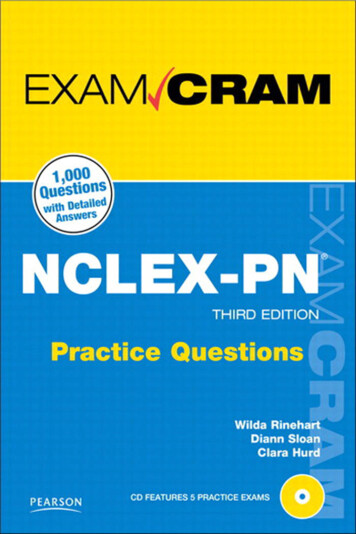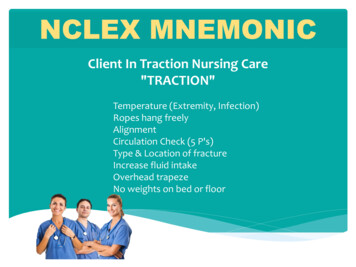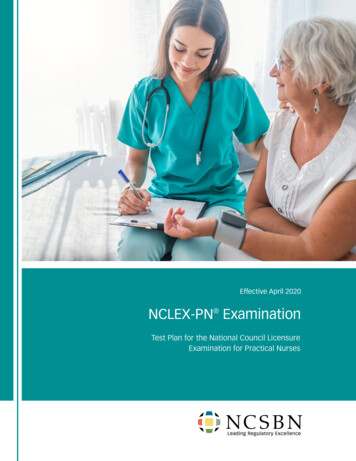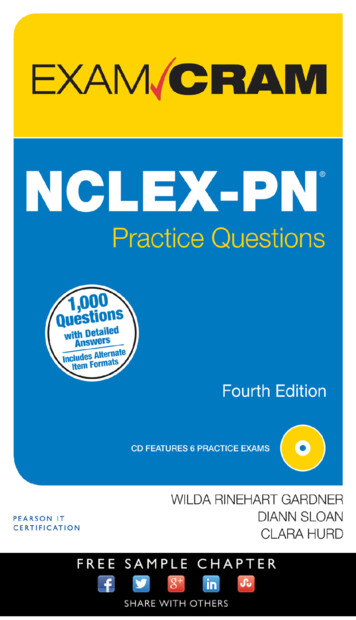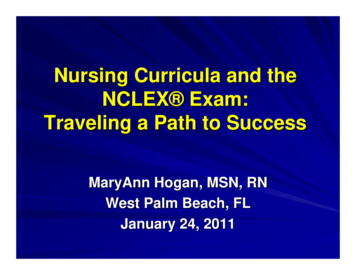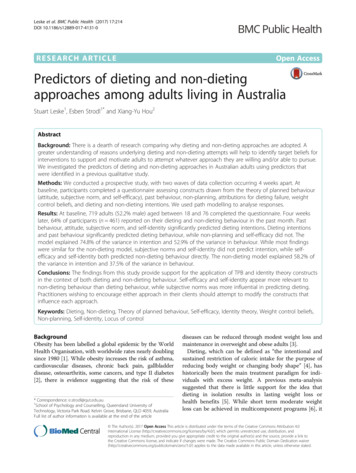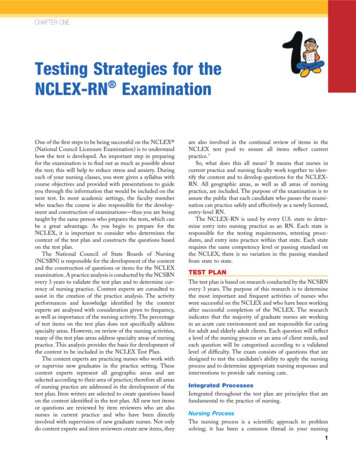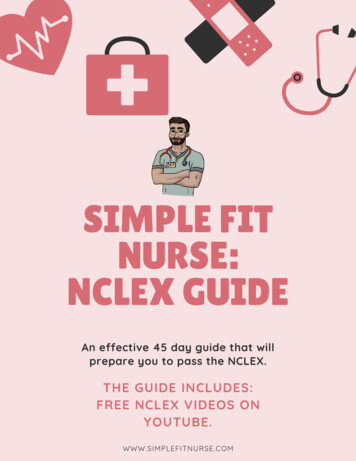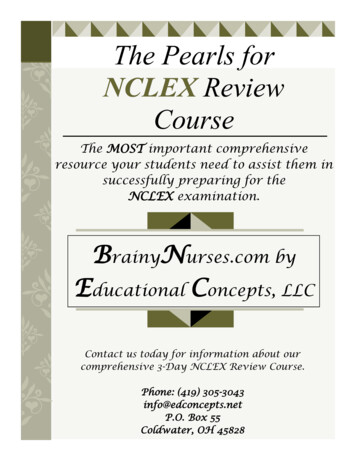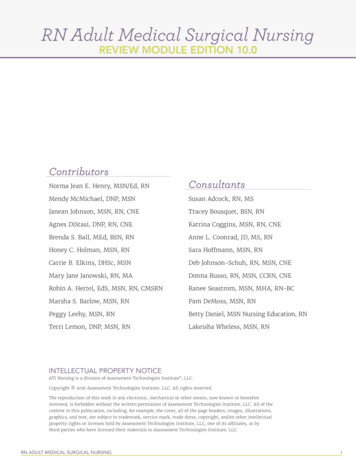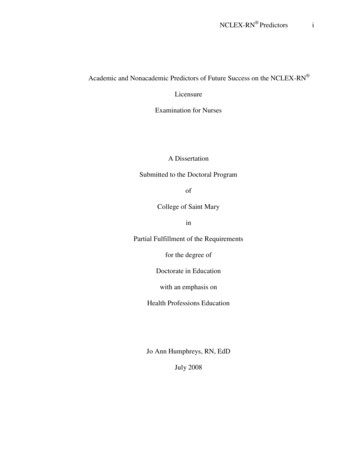
Transcription
NCLEX-RN PredictorsAcademic and Nonacademic Predictors of Future Success on the NCLEX-RN LicensureExamination for NursesA DissertationSubmitted to the Doctoral ProgramofCollege of Saint MaryinPartial Fulfillment of the Requirementsfor the degree ofDoctorate in Educationwith an emphasis onHealth Professions EducationJo Ann Humphreys, RN, EdDJuly 2008i
NCLEX-RN PredictorsiiAbstractThe purpose of this retrospective, descriptive study was to explore possible differencesbetween academic and nonacademic predictors and subsequent success rates on NCLEXRN examination in a sample of nursing students. This is a high-stakes examinationbecause graduate nurses must successfully complete this requirement to practice asregistered nurses. Data were examined from academic records of 338 nursing graduateswho completed associate degree requirements at a college in the Midwest between April2006 and August 2007. Descriptive and inferential statistics were explored to discernpossible differences between the dependent variable, NCLEX-RN passage rates andvarious independent variables. Statistical analysis revealed the academic predictors to begood indicators of future success on NCLEX-RN . For college GPA the t-test forequality of means revealed t 9.080, df 204.100, p .000 and mean difference .35534. Conversely, high school GPA demonstrated t 1.286, df 157.528, p .200 andmean difference .08081. An explanation of this significant finding with college GPAand lack of significance in high school GPA may be the rigor of nursing educationcompared to high school course work. Composite ACT as well as math and science ACTwere highly predictive of future success on NCLEX-RN . The mean ACT score for thosewho passed NCLEX-RN was 21.6387 and the mean ACT score for those who failed thelicensure examination was 19.5968. Nonacademic predictors were not as strongindicators of future success on the licensure examination as academic predictors,however. Only student age at the time of sitting for the NCLEX examination proved to bepredictive of future success. Both the HESI Exit Exam (E2) and ATI Comprehensive RNPredictor were predictive of future success on NCLEX-RN .
NCLEX-RN PredictorsiiiAcknowledgmentsThis author wishes to acknowledge the expertise and flexibility of facultymembers of College of Saint Mary for creating and administering a highly successfulhybrid Doctorate in Education with an emphasis on Health Professions EducationProgram. My thanks are extended especially to Dr. Peggy Hawkins for her direction,motivating ability and confidence in my pursuit to complete this project. I am indebted tomy colleagues at Mercy College of Health Sciences for their support and assistanceduring my educational journey, as well as for their time and talent in providing invaluablecomments during this project. A special thanks to my committee members, Dr. Hawkins,Dr. Connie Clark and Dr. Patricia Morin for their scrutiny and patience in evaluation ofthis study. In addition, I would not have completed this project without the kindness, loveand support of my family and friends, especially my husband, Mike, and our son, Tyler.
NCLEX-RN PredictorsivTable of ContentsAcknowledgments. iiiTables . viFigures. viiiChapter One . 1Introduction . 1Background Information . 1Purpose of the Study . 4Method of the Study. 4Research Questions . 5Definition of Terms. 6Delimitations . 8Limitations . 9Significance of the Study . 9Chapter Two. 11Review of the Literature . 11Predictors of Readiness for NCLEX-RN . 11Types of Nursing Programs . 15Theoretical Framework . 16Adult Learning Theory . 16Classical Test Theory. 19Critical Thinking Theory . 21NCLEX-RN Test Plan . 22
NCLEX-RN PredictorsvAt-Risk Students . 25Progression Policies . 27Chapter Three. 29Methodology . 29Study Design . 29Chapter Four . 39Results . 39Introduction . 39Descriptive Statistics . 41Inferential Statistics . 58Chapter Five . 76Discussion . 76Presentation of Results . 76Discussion of Hypotheses . 78Limitations of the Study. 80Conclusions . 81Recommendations for Future Research . 82References . 85Appendix A . 92Appendix B . 95
NCLEX-RN PredictorsviList of Tables and FiguresTablesTable 1Descriptive Statistics40Table 2Gender42Table 3Group Statistics - College GPA59Table 4Independent Samples Test – College GPA59Table 5Group Statistics – High School GPA59Table 6Independent Samples Test – High School GPA60Table 7Group Statistics – ACT 61Table 8Independent Samples Test – ACT 61Table 9Group Statistics – Math ACT61Table 10Independent Samples Test – Math ACT62Table 11Group Statistics – Science ACT62Table 12Independent Samples Test – Science ACT62Table 13Previous College credits63Table 14Chi-Square Tests – Previous College credits63Table 15Nursing Courses NCLEX-RN 64Table 16Chi-Square Tests – Nursing course64Table 17Science Course NCLEX-RN 65Table 18Chi-Square Tests – Science course65Table 19Chi-Square Tests – Repeated course66Table 20Repeated Course NCLEX-RN 66Table 21Age at NCLEX Sitting67Table 22Age at NCLEX Sitting – t-test67
NCLEX-RN PredictorsviiTable 23Gender NCLEX-RN 68Table 24Chi-Square Tests – Gender68Table 25Ethnicity NCLEX-RN 69Table 26Chi-Square Tests – Ethnicity69Table 27Marital Status NCLEX-RN 70Table 28Chi-Square Tests – Marital Status70Table 29Independent Samples Test – HESI Exit Test72Table 30Group Statistics – HESI Exit Test72Table 31Group Statistics – ATI Comp. Predictor72Table 32Independent Samples Test – ATI Comp. Predictor73Table 33Completion Date NCLEX-RN 74Table 34Chi-Square Tests - Completion Date74Table 35Program type75Table 36Chi-Square Tests – Program type75
NCLEX-RN PredictorsviiiFiguresFigure 1ASN and BSN Program type39Figure 2Age at NCLEX sitting41Figure 3Ethnicity42Figure 4College GPA43Figure 5High School GPA44Figure 6ACT Scores46Figure 7Math ACT47Figure 8Science ACT48Figure 9Previous college credits49Figure 10HESI Exit Test50Figure 11ATI Comprehensive Predictor Test51Figure 12NCLEX-RN Passage Rate52Figure 13Marital status53Figure 14ASN Program Completion Rate54Figure 15Nursing Course Grade55Figure 16Science Course Grade56Figure 17Repeated Course57
NCLEX-RN Predictors1Chapter OneIntroductionBackground InformationThere are three major levels of educational preparation that lead to entry-levelpractice of registered nursing; associate degree, diploma and baccalaureate. The terminalrequirement of each of these programs of study is successful completion of the licensureexamination (NCLEX-RN ) of the National Council of State Boards of Nursing(NCSBN). This is a high-stakes examination because graduates of nursing programs mustsuccessfully complete this requirement to practice in the field of nursing. Failure onNCLEX-RN is associated with a variety of negative issues for the graduated nursingstudent. Some of these factors include low self-esteem, delay in joining the workforce,added expense of retaking NCLEX-RN plus loss of RN earnings (Nibert & Young,2001). In addition, nursing programs have negative issues associated with failure ofgraduates on NCLEX-RN because accreditation agencies and state boards of nursingmeasure the quality of nursing programs based on licensure passage rates. Because of thevalue placed on success on the licensure examination, it is vital for both students andfaculty to develop a process of determining predictors of success prior to graduation andcandidacy for NCLEX-RN (Lauchner, Newman, & Britt, 1999).According to current Registered Nurse (RN) workforce statistics, a nursingshortage crisis exists. Renaud and Miller (2003) reported the nursing shortage originallyexpected in 2007 actually began in 2000 with an estimated 6% deficit of nurses (nationalsupply of nurses, 1.89 million with demand at 2 million. The United States (U.S.) HealthResources Service Administration (HRSA) released projections of a possible 12% deficit
NCLEX-RN Predictors2in nursing workforce by 2010 and even a possible additional reduction to 29% by 2020(HRSA, 2008).The U.S. Department of Labor (2008) reported “registered nurses are projected togenerate 587,000 new jobs, among the largest number of new jobs for any occupation.Additionally, hundreds of thousands of job openings will result from the need to replaceexperienced nurses who leave the occupation” (p. 1). Current workforce statisticsindicated a 23% increase in the projected employment need for registered nurses from2,505,000 in 2006 to 3, 092,000 in 2016. This was a change of 587,000 nursing positions(U.S. Department of Labor, 2008). Bentley (2006) stated that by the year 2010 aprojected need for a million new nurses and ones to take existing positions will occur.This statement by Bentley (2006) indicated a need to both increase numbers of entrantsinto nursing programs and for student completion of those programs with subsequentsuccess on NCLEX-RN .In the 1950s there was a proliferation of two-year associate degree (AD) nursingprograms developed to meet the urgent need for bedside nurses. Due to the need fornurses to join the workforce in a timely manner, no differentiation was made in thelicensure requirements for AD, Diploma (typically three-year programs) andBaccalaureate nursing programs. All graduate nurses wrote the same NCLEX-RN licensure examination and continue to do so. This fact of one licensure examination forall program types has led to an entry-into-practice debate that continues to the presenttime. Diploma programs, however, have declined greatly in number while AD andBaccalaureate programs remain widespread throughout the country.
NCLEX-RN Predictors3Accelerated Bachelor of Science in Nursing (BSN) programs have gained innumbers and popularity in response to the demand for licensed nurses in 2008. Manynursing programs offer students with a prior bachelor‟s degree or substantive hourstoward a degree an opportunity to finish a program of study toward an accelerated BSNin one to three years. This allows a graduate to enter the workforce much more quicklythan with other nursing programs and takes advantage of the educational and lifeexperiences gained in previous college matriculation. Students in accelerated BSNprograms are usually more mature, experienced adult learners who tend to adapt well tonursing education (Bentley, 2006).Successful completion of the nursing licensure examination is the mandatedstandard to pursue the practice of nursing. The nursing licensure examination(NCLEX-RN ) is updated on a triennial basis by a panel of judges of the NationalCouncil of State Boards of Nursing (NCSBN). The NCLEX-RN blueprint is based on ajob analysis conducted with a random sample of entry-level licensed nurses from acrossthe United States and its territories. To conduct the job analysis, a survey is disseminatedto a random sample of graduates of nursing programs (AD, diploma and baccalaureate).Specific questions are related to practice issues encountered by those graduates during thefirst six months of nursing practice. The questions in the survey are related to patient caresituations and reflect the acuity of patients in health care settings. Due to increasedacuity, the passing standard has been increased in each of the past two updates of thelicensure examination (2004 and 2007). The passing standard is based on the minimumlevel of competence required for nursing practice because safe practice continues to be a
NCLEX-RN Predictors4major concern and is reflected in the increased rigor of the licensure examination(NCSBN, Passing Standard, 2007).Purpose of the StudyThe purpose of the study was to investigate academic and nonacademic predictorsof success on the National Council Licensure Examination for Registered Nurses(NCLEX-RN ), an examination that nursing graduates must successfully complete at theend of their program of study in order to practice nursing. Potential academic predictorsincluded high school grade point average (GPA), college GPA, ACT/SAT scores, nursingcourse grades, science and math grades, previous college credits and scores onstandardized testing during the program of study and at the end of the program of study.There were also many possible nonacademic predictors such as age, gender, maritalstatus, number of dependents, commuter status and hours worked per week during theprogram of study.Method of the StudyA five-semester Associate of Science in Nursing (ASN) program (includingaccelerated Bachelor of Science in Nursing (BSN) students) was used for this descriptiveresearch study. Data were examined retrospectively from records of students whocompleted the program of study in 2006 and 2007. Students who completed the programin spring 2006 (N 96), summer 2006 (N 78), spring 2007 (N 92), and summer 2007(N 72), a total of 338 students, were included in the sample. Descriptive statistics wereutilized to describe and summarize the characteristics of the sample, to examinerelationships between variables and to assess differences in those who successfully
NCLEX-RN Predictors5completed NCLEX-RN and those who did not. Inferential statistics were utilized tofurther delineate possible statistically significant differences between predictors andlicensure examination results. Academic predictors and nonacademic predictors werecorrelated with NCLEX-RN success. A comparison of scores on two types ofstandardized testing utilized at the end of the program as predictors of subsequentNCLEX-RN success (Health Education Systems, Inc., HESI Exit exam, and AssessmentTechnologies, Inc., ATI Comprehensive RN Predictor) was completed.Research Questions1. Is there a significant difference between selected academic predictors and subsequentsuccess on NCLEX-RN ?2. Is there a significant difference between selected nonacademic predictors andsubsequent success on NCLEX-RN ?3. Is there a significant relationship between student scores on two types of exitstandardized tests, Health Education Systems, Inc. (HESI) (2006 students) andAssessment Technologies, Inc. (ATI) (2007 students) and subsequent success onNCLEX-RN ?4. Is there a significant difference between 2006 students‟ and 2007 students‟ successrate on NCLEX-RN ?5. Is there a significant difference between ASN students and accelerated BSN students‟success rate on NCLEX-RN ?
NCLEX-RN Predictors6Definition of TermsAssociate Degree (AD)Associate degree education (basic), typically a two-year program of study.Associate of Science in Nursing Degree (ASN)Associate degree education with an emphasis in science, generally a two-yearprogram of study.Bachelor of Science in Nursing Degree (BSN)Baccalaureate degree education with an emphasis in science, and is typically afour-year program of study.Accelerated BSNStudents who have a baccalaureate degree or have completed 30 to 35 credithours of liberal arts and science (LAS) course work prior to beginning theAssociate of Science in Nursing (ASN) program may elect to join the AcceleratedBSN program and complete the requirements in a three-year time period. Thesestudents are held to the same GPA and graduation requirements as ASN students.Two plus two nursing programsStudents complete the traditional associate degree nursing program inapproximately two years and are eligible for the licensure examination. Studentsthen continue the program of study for approximately two additional years tocomplete the requirements for a bachelor‟s degree in nursing.Entry-level nursing practiceAt the completion of the nursing degree (ASN, BSN or accelerated BSN) thegraduated student sits for the licensure examination (NCLEX-RN ). Upon receipt
NCLEX-RN Predictors7of successful NCLEX-RN results, the registered nurse begins practice in abeginning nursing position.At-risk studentsStudents who are at risk of failure on NCLEX-RN based on college GPA,SAT/ACT score, and nursing course work during the associate degree portion ofthe nursing program.Assessment Technologies, Inc. (ATI)A testing corporation that partners with nursing institutions to improve contentmastery and assist students in preparation for the nursing licensure examination atthe end of the program. The Comprehensive Assessment and Retention Package(CARP) is the product disseminated by ATI.Health Education Systems, Inc. (HESI)A testing corporation that provides custom tests, at pre-determined points in anursing curriculum, and an exit test (HESI Exit Exam, E2) at the end point of thecurriculum.NCSBNNational Council of State Boards of Nursing is a professional organization thatdevelops and administers the nursing licensure examination.NCLEX-RN Licensure examination, with successful completion, allows one to practicenursing within the state of issue (NCSBN, nd). Validity and reliability of thisexamination have been determined (see Appendix B). Job analysis of 6000 nurses
NCLEX-RN Predictors8in entry-level nursing practice is completed on a triennial basis to ensure that theexamination is consistent with the current level of practice.Nurse educators/facultyNurses who plan, design, facilitate, implement and evaluate programs of study fornursing students.Progression policyThis policy identifies the requirement for students‟ successful completion ofpredetermined criteria as well as the program of study to receive a degree andtranscript. The policy may include attainment of a benchmark score on an exitstandardized test, participation in a review course, or completion of other criteriato complete program requirementsDelimitationsPotential delimitations exist with this study. Only one college of nursing wasexamined although a sizable sample of students completed the program of study duringthe two-year period of the investigation. In addition, the NCLEX-RN format and thepassing standard changed for all candidates in 2007. This allowed for a somewhatdifferent test and passing standard than the 2006 candidates encountered. A furtherdelimitation was a change in the progression policy utilized at the institution under studyfor the 2007 students compared to the 2006 students. Ethical concerns that prompted thischange in progression policy will be further delineated in the review of literature. WhileASN and accelerated BSN students completed the same basic program of study, theaccelerated BSN students had the opportunity to elect completion of BSN courses at thesame time as the basic nursing courses. This may have added to the workload, increased
NCLEX-RN Predictors9stress, and increased expectations of the accelerated BSN student compared to the ASNstudent.LimitationsThere were some limitations in this study centering on methods of analysis ofdata. The chi-square (χ2) test is a nonparametric statistic which is inherently less powerfula measurement than a parametric statistic (Polit & Beck, 2006). Analysis of data includednominal data (pass/fail statistics) on NCLEX-RN that allowed for only one or the othercategory as no numerical scores were provided for the NCLEX-RN licensureexamination. Nominal data is at the lowest level of measurement and, therefore, requirednonparametric statistical analysis. For this reason, interval and ratio data from othervariables were examined using parametric tests.Significance of the StudyPrediction of student success on NCLEX-RN has been an important issue forfaculty in nursing programs for the last 20 years (Haas, Nugent, & Rule, 2004). Theshortage of nurses, both locally and nationally, has increased the need for graduate nursesto successfully complete NCLEX-RN and join the workforce. In addition, the NCSBNincreased the passing standard in 2004 and 2007 to align the examination with jobanalysis data suggesting a need for a higher level of practice based on increased patientacuity (Morrison, Free, & Newman, 2004; Davenport, 2007). This increased difficultylevel of the examination multiplies the need to discover a defining method to predictsuccess on NCLEX-RN for students in nursing programs. A precise method would
NCLEX-RN Predictors10allow for remediation systems to be developed early in programs of study to increase theprobability of success on the licensure examination and would in turn have an effect onpsychological and financial implications for students and workforce issues for theprofession of nursing.
NCLEX-RN Predictors11Chapter TwoReview of the LiteratureFor organizational purposes this review of the literature is divided into thefollowing sections, predictors of readiness for NCLEX-RN , types of nursing programs,theoretical framework, NCLEX-RN test plan, at-risk students and progression policies.The theoretical framework included information on adult learning theory as well asclassical test theory and critical thinking theory.Predictors of Readiness for NCLEX-RN According to Barkley, Rhodes, and Dufour (1998), success on NCLEX-RN wasreported in the literature to have many predictive factors, both academic andnonacademic. Two variables from nursing programs seen consistently as predictive ofNCLEX-RN success were, final course grade in the senior-level medical-surgical courseand cumulative GPA in the program (Daley, Kirkpatrick, Fraizer, Chung & Moser,2003). In a meta-analysis by Campbell and Dickson (1996) of 172 studies completedfrom 1981 to 1990, it was noted that cumulative GPA in nursing course work was thebest predictor of NCLEX-RN success. However, as the final cumulative GPA isdetermined post completion of the program, this does not allow for remediation thatcould increase the likelihood of NCLEX-RN success.Crow, Handley, Morrison, and Shelton (2004) also investigated factors that werepredictive of NCLEX-RN success. These authors utilized survey methodology toconduct a descriptive study on a national sample to extrapolate the best predictors ofsuccess in BSN programs as well as future success on NCLEX-RN . A response rate of31.2 percent from 513 BSN programs was obtained on a second mailing. Findings
NCLEX-RN Predictors12identified several positive predictors of success such as the use of exit examinations as agraduation requirement, admission requirements of ACT/SAT and standardized preadmission testing and clinical proficiency testing, and commercial review courses at theend of the program. This survey also cited the demographic variable of white, nonHispanic as being predictive of future NCLEX-RN success.Alexander and Brophy (1997) reported Scholastic Aptitude Test (SAT) verbalscores, nursing GPA, and National League for Nursing (NLN) comprehensiveachievement test scores were the best predictors of NCLEX success in the associate andbaccalaureate sample group (N 94). In addition, science and math grades were seen aspredictive of success both in nursing programs and on the NCLEX-RN licensingexamination (Waterhouse & Beeman, 2003). Potolsky, Cohen and Saylor (2003) reportedthat prerequisite science course outcomes were reliable predictors of program andsubsequent NCLEX-RN success. In a similar study, Roncoli, Lisanti and Falcone (2000)found that higher grades in science and nursing courses increased the likelihood ofsuccess on the licensure examination. Conversely, in a descriptive study by Arathuzikand Aber (1998) utilizing a convenience sample of 79 nursing students, factors predictiveof future success on NCLEX-RN were determined to be higher cumulative GPA, wellhoned study skills, and fewer external pressures such as family and work responsibilities.Bentley (2006) reported a high correlation between strong clinical behaviors and coursegrades for clinical and subsequent success on NCLEX-RN .In a study using a quick, hand-scored assessment tool developed by the authors,the Risk Appraisal Instrument (RAI), Barkley et al. (1998) found the tool “correctlyclassified 95.59 percent of those students who passed the NCLEX-RN and 76.92 percent
NCLEX-RN Predictors13of those who failed the exam” (p. 136). The procedure consisted of analysis of studentrecords with a weight determined for course grades; “using a trial-and-error technique,weights for each item were determined following repeated analysis of the data” (Barkleyet al., 1998, p. 136). An RAI score was then determined for each student.In an adaptation of the RAI developed by Barkley et al. (1998), Waterhouse andBeeman (2003) identified that 61% of NCLEX-RN failures were correctly classifiedutilizing the tool, Delaware Risk Appraisal Instrument (DRAI). DRAI scores of 176 orbelow were found to correlate with high risk of failure of NCLEX-RN while scores of253 and above determined low risk of licensure failure. The RAI (or DRAI) are moresimplistic tools and did not approach the statistical accuracy of more complex methodsbut provided a useful, quick method of ascertaining those students at risk early in nursingprograms (Barkley et al, 1998; Waterhouse & Beeman, 2003).Admission criteria have served to be good predictors of success in nursingprograms and subsequent pass scores on the NCLEX-RN (Gallagher, Bomba & Crane,2001). Yin and Burger (2003) reported use of admission criteria as predictors of futuresuccess in nursing programs and on NCLEX-RN better serves society because thosestudents who are most likely to complete programs of study and enter the work force areidentified. In addition, those who are more likely to struggle in programs of study arerecognized so remediation services can be provided at an early point in the curriculum.Computer anxiety is a form of test anxiety that may have an unfavorable effect onstudent performance, especially for non-traditional students. “The computerized licensureexam, CAT NCLEX-RN , adopted in 1998, has a
examination (NCLEX-RN ) of the National Council of State Boards of Nursing (NCSBN). This is a high-stakes examination because graduates of nursing programs must successfully complete this requirement to practice in the field of nursing. Failure on NCLEX-RN is associated with a vari

